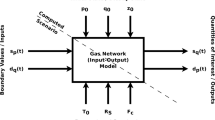Abstract
Due to strict regulatory rules in combination with complex nonlinear physics, major gas network operators in Germany and Europe face hard planning problems that call for optimization. In part 1 of this paper we have developed a suitable model hierarchy for that purpose. Here we consider the more practical aspects of modeling. We validate individual model components against a trusted simulation tool, give a structural overview of the model hierarchy, and use its large variety of approximations to devise robust and efficient solution techniques. An extensive computational study demonstrates the suitability of our models and techniques for previously unsolvable problems in gas network planning.














Similar content being viewed by others
Notes
SIMONE software. http://www.liwacom.de.
General Algebraic Modeling System (GAMS). http://www.gams.com/.
References
Burgschweiger J, Gnädig B, Steinbach MC (2009) Nonlinear programming techniques for operative planning in large drinking water networks. Open Appl Math J 3:14–28
Byrd RH, Nocedal J, Waltz RA (2006) KNITRO: an integrated package for nonlinear optimization. In: Di Pillo G, Roma M (eds) Large scale nonlinear optimization. Springer, New York, pp 35–59
Drud AS (1996) CONOPT: a system for large scale nonlinear optimization, reference manual for CONOPT subroutine library. Technical Report, ARKI Consulting and Development A/S, Bagsvaerd
Elad M (2010) Sparse and redundant representations: from theory to applications in signal and image processing. Springer, New York
Fügenschuh A, Geißler B, Gollmer R, Hayn C, Henrion R, Hiller B, Humpola J, Koch T, Lehmann T, Martin A, Mirkov R, Morsi A, Rövekamp J, Schewe L, Schmidt M, Schultz R, Schwarz R, Schweiger J, Stangl C, Steinbach MC, Willert BM (2014) Mathematical optimization for challenging network planning problems in unbundled liberalized gas markets. Energy Syst 5:449–473
Gill PE, Murray W, Saunders MA (2002) SNOPT: an SQP algorithm for large-scale constrained optimization. SIAM J Optim 12:979–1006
Humpola J, Joormann I, Oucherif D, Pfetsch ME, Schewe L, Schmidt M, Schwarz R (2015) GasLib—a library of gas network instances. http://www.optimization-online.org/DB_HTML/2015/11/5216.html
Joormann I, Schmidt M, Steinbach MC, Willert BM (2015) What does “feasible” mean? In: Koch T, Hiller B, Pfetsch ME, Schewe L (eds) Evaluating gas network capacities, chapter 11., SIAM-MOS series on optimization, SIAM, Philadelphia, pp 211–232
Koch T, Hiller B, Pfetsch ME, Schewe L (eds) (2015) Evaluating gas network capacities, SIAM-MOS series, on optimization, SIAM, Philadelphia
Králik J, Stiegler P, Vostrý Z, Záworka J (1988) Dynamic modeling of large-scale networks with application to gas distribution, vol 6., studies in automation and control. Elsevier Science Publishers, New York
LaMaTTO++: a framework for modeling and solving mixed-integer nonlinear programming problems on networks (2015) http://www.mso.math.fau.de/edom/projects/lamatto.html
LIWACOM Informations GmbH and SIMONE Research Group s.r.o. (2004) Gleichungen und Methoden, Benutzerhandbuch
LIWACOM Informations GmbH and SIMONE Research Group s.r.o. (2009) SIMONE API Interface documentation
Martin A, Geißler B, Hayn C, Hiller B, Humpola J, Koch T, Lehmann T, Morsi A, Pfetsch M, Schewe L, Schmidt M, Schultz R, Schwarz R, Schweiger J, Steinbach MC, Willert BM (2011) Optimierung Technischer Kapazitäten in Gasnetzen. In: Optimierung in der Energiewirtschaft, vol. 2157 of VDI-Berichte, pp 105–114
Murtagh BA, Saunders MA (1993) Minos 5.4 user’s guide. Technical Report SOL 83-20R, Department of Operations Research, Stanford University, Stanford
Pfetsch ME, Fügenschuh A, Geißler B, Geißler N, Gollmer R, Hiller B, Humpola J, Koch T, Lehmann T, Martin A, Morsi A, Rövekamp J, Schewe L, Schmidt M, Schultz R, Schwarz R, Schweiger J, Stangl C, Steinbach MC, Vigerske S, Willert BM (2015) Validation of nominations in gas network optimization: models, methods, and solutions. Optim Methods Softw 30:15–53
Rosenthal RE (2008) GAMS—a user’s guide. GAMS Development Corporation
Schmidt M, Steinbach MC, Willert BM (2014) High detail stationary optimization models for gas networks. Optim Eng 16:131–164
Wächter A, Biegler LT (2006) On the implementation of an interior-point filter line-search algorithm for large-scale nonlinear programming. Math Program 106:25–57
Yin W, Zhang Y (2008) Extracting salient features from less data via \(\ell _1\)-minimization. SIAG/OPT Views-and-News 19:11–19
Záworka J (1993) Project SIMONE—achievements and running development. In: Proceedings of 2nd international workshop SIMONE on innovative approaches to modeling and optimal control of large scale pipeline networks. Prague, pp 1–24
Acknowledgments
This work has been supported by the German Federal Ministry of Economics and Technology owing to a decision of the German Bundestag. The responsibility for the content of this publication lies with the authors. This research has been performed as part of the Energie Campus Nürnberg and supported by funding through the “Aufbruch Bayern (Bavaria on the move)” initiative of the state of Bavaria. We would also like to thank our industry partner Open Grid Europe GmbH and the project partners in the ForNe consortium. Finally, we thank Björn Geißler and Antonio Morsi for many suggestions for improvement.
Author information
Authors and Affiliations
Corresponding author
Appendices
Appendix 1: Computational results for temperature dynamics on the GasLib-582 test set
Appendix 2: Model aspect graphs
See Figs. 17, 18, 19, 20, and 21.
Model aspect graph of pipes (isothermal). (*) If the exact solutions of the momentum equation are chosen as a concretization, not every choice of the compressibility factor is possible, cf. Schmidt et al. (2014). In addition, not every combination of pipe slope and compressibility factor is possible. (o) To achieve a smooth NLP model, flow bound strengthening has to be applied. (+) Only possible for horizontal pipes
Appendix 3: GasLib-582 instances
See Table 13.
Rights and permissions
About this article
Cite this article
Schmidt, M., Steinbach, M.C. & Willert, B.M. High detail stationary optimization models for gas networks: validation and results. Optim Eng 17, 437–472 (2016). https://doi.org/10.1007/s11081-015-9300-3
Received:
Revised:
Accepted:
Published:
Issue Date:
DOI: https://doi.org/10.1007/s11081-015-9300-3











